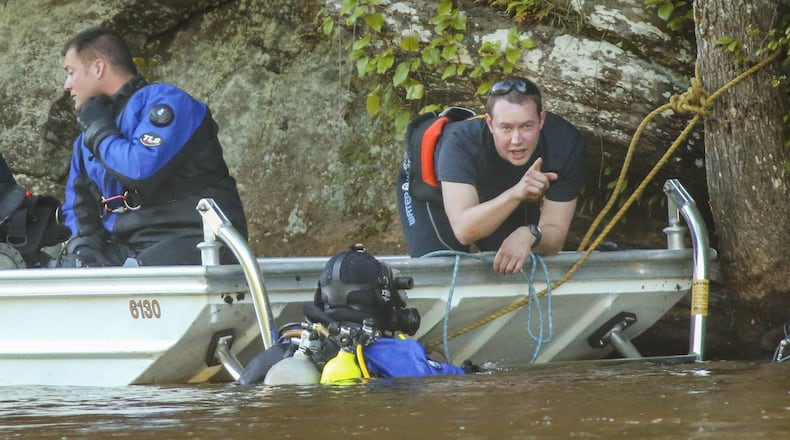Labor Day traditionally heralds the end of yet another summer — and brings with it the risk that more Georgians will drown while enjoying their last bit of fun in the sun.
The number of people drowning while swimming, boating, fishing and hunting in Georgia has continued to rise year over year since 2013, according to an Atlanta Journal-Constitution analysis of seven years of state death data, even as the state has worked to reduce such deaths.
“So many of these deaths are preventable if people followed safety rules,” said Mark McKinnon, public affairs officer for the state Department of Natural Resources, whose rangers patrol Lake Lanier and other large lakes.
And swimming pools remain a danger, particularly for children under the age of 5, the AJC found.
The latest drowning occurred Friday night when a 21-year-old college student became separated from a jet ski and was found floating near a boat ramp on Lake Lanier. The death of Bailey Dean O'Shields of the Suwanee area fit the profile of drowning victims analyzed by the AJC.
The overwhelming majority of drownings in recreational water use in Georgia in recent years were male, and the majority of males who drowned were age 35 or younger, the newspaper found. Last year, 100 out of 113 victims were male. Nationally, about four people out of five who drown are male, the Centers for Disease Control and Prevention (CDC) says.
The phenomenon has played out in the Atlanta area again in the past month: Two young men died just a few weeks apart after jumping from an old, abandoned bridge in Suwanee into the Chattahoochee River.
Perez Tamfu, 17, was a rising senior at Mountain View High School, where he played soccer. Joshua Katikala, 20, was a pastor's son who played guitar as worship team leader for a Cumming church.
Both were strong swimmers. Neither wore life jackets. O'Shields was also not wearing a life jacket when he was pulled from Lake Lanier Friday, a Gwinnett County Fire and Emergency Services spokesman said.
"Males in their late teens and early 20s are high risk-takers. No matter how good a swimmer you are, if you jump from high up and hit a rock, your swimming skills won't do you much good," said B. Chris Brewster, the moderator at the group Water Safety USA.
“Coast Guard members wear life vests while on the water because they understand that unexpected events happen, even though they are all excellent swimmers. People may faint and fall in, the boat may hit a rock and knock you out, people may slip out of the boat and get swept up in a current.”
Researchers offer many explanations for the gender disparity in drowning victims. Men are more likely to drink or use drugs while out on the water and are less likely to wear life jackets, according to a 1996 study in the American Journal of Public Health. Men are also more likely to engage in high-risk activities, such as jumping off an abandoned bridge.
Males accounted for more than three-fourths of the people who drowned in Georgia in the week-long period around each Labor Day between 2010 and last year, the AJC found.
Lanier: Most visitors, many deaths
More than half of the people who drowned during recreational water use in Georgia drowned in a lake, pond, river, stream or in the ocean, the newspaper found.
That statistic could be higher, because about one of five drowning victims’ death certificates don’t spell out exactly where they were injured.
While boaters hear warnings each year about the dangers of Lake Lanier and Lake Allatoona — state wildlife rangers have investigated more than four dozen deaths on the two big lakes since 2010 — the AJC also found at least 20 people whose death certificates described them as drowning in the same time period in the Chattahoochee.
That would make the river the third-deadliest body of water in the state, behind Allatoona.
The U.S. Army Corps of Engineers, which maintains Lake Lanier, estimates that about 7.5 million people visit the lake each year, making it the most heavily used Corps lake in the state. More than three times as many people’s death certificates reported them drowning at Lake Lanier than drowned in all of Georgia’s coastal waters.
Meanwhile, the Chattahoochee, which was dammed to create Lake Lanier, famously winds 400 miles down through the hills of Habersham County, down through the valleys of Hall County and past Atlanta’s sprawl to Lake Seminole.
Georgia’s legislature cracked down four years ago on drunken and unsafe boating. The legal blood-alcohol limit for boaters was dropped from 0.10 to 0.08, making boat operators subject to the same sobriety expectations as the driver of a car.
Lawmakers also required anyone on a moving boat younger than 13 to wear a life jacket, and required safety classes for boaters born after 1997.
Gov. Nathan Deal signed the bill in a ceremony held at Lake Lanier while recalling the three youngsters for whom the new laws were named. All three boys, ages 9, 11 and 13, lost their lives at the lake the year before.
Credit: JOHNNY CRAWFORD / JCRAWFORD@AJC.
Credit: JOHNNY CRAWFORD / JCRAWFORD@AJC.
Since then, the state launched its SPLASH initiative, a program intended to increase public awareness about the need for safety while boating and swimming.
At the same time, Georgia’s population grew by more than 3percent between 2013 and last year, according to Census figures, putting more Georgians in contact with the water.
“We can’t be everywhere to supervise people out on the water, just like the Department of Public Health can’t be in every house telling people not to leave their babies alone in the bathtub even for one second,” McKinnon said. “The best we can do is try to keep hammering home these messages, and maybe people will hear them enough that they’ll take them to heart.”
The state recognizes the need for strong safety messaging, McKinnon said. The DNR’s campaign to reduce drowning deaths includes partnerships with the National Association of State Boating Law Administrators, Georgia Power, the state Department of Public Health, the Georgia Bureau of Investigation, the U.S. Army Corps of Engineers and other public and private organizations.
‘No one is responsible’
But swimmers — and parents — should know that pools are still dangerous.
Even though just one in four recreational drownings happens in a pool or hot tub, that’s still, on average, more than two dozen deaths a year in Georgia, the AJC found.
And of all children age 5 and under who drowned during recreational water use, three-fourths of those children drown in a pool in an average year, the newspaper found.
New building codes that kicked in at the beginning of this year require four-foot-high gates with locks or self-latching devices for all pools in the state, including private pools and others that aren’t already regulated by the state for public or community use. Some of the state’s more urban counties already had such rules in place, but the new building code covers all 159 counties.
“However, there is typically not an ongoing inspection program to verify ongoing compliance with private pools,” Nancy Nydam, a spokeswoman for the state Department of Public Health, wrote in an email to the AJC.
The death data reviewed by the newspaper shows that small children can easily get into, or fall into, pools, ponds and other standing water formations when parents lose sight of them. “Patient found submerged in pool,” reads the death certificate of a 1-year-old boy who was rushed to Children’s Healthcare of Atlanta at Egleston Hospital in 2012 but did not survive. “Found floating in pool” reads the certificate for another 1-year-old boy who drowned at his DeKalb County apartment complex that same year.
“Child went missing and was found in the pool where she had fell into,” reads the records for a 3-year-old girl who died at a home in northwest Georgia two years ago.
It doesn’t take much water to drown a small child. Two 1-year-old boys drowned in buckets of water, one in 2010, the other last year, the death data shows.
Water Safety USA’s slogan for this year is “Watch Your Kids,” said Brewster, who is a moderator with the program. The group wants to parents “to always keep an eye on children while they are around water. We advise they designate a ‘watcher.’
“Drowning deaths often occur with several adults present, because when everyone is responsible, no one is responsible. They think no kid can drown if there are five adults and 10 kids in a pool, but everyone assumes someone else is keeping an eye out. It’s surprisingly difficult to see a child under the water.”
How we got the story
The Atlanta Journal-Constitution analysis looked at seven years of death certificate data obtained under the Georgia Open Records Act from the state Department of Public Health.
The newspaper identified more than 900 individuals for whom drowning was listed as a cause of death or a contributing factor in their death and who were listed as having been fatally injured in Georgia.
The AJC then reviewed all 900 cases to exclude people who weren’t engaged in recreational activity, including people who died through homicide or suicide; people who accidentally or intentionally drove or piloted vehicles or aircraft into bodies of water; people who drowned in a bathtub, shower, sink, storm drain, ditch, flooded field or goldfish pond; deaths in which the victim was clearly not engaged in a recreational activity, such as mowing grass; and deaths where the description on the death certificate was unclear about the location of the drowning.
The exclusions sought to narrow down the list of drowning victims to those who drowned in lakes, ponds, rivers, streams, the ocean, swimming pools and hot tubs during recreational water use.
The AJC also cross-referenced the death certificate data with data from the Georgia Department of Natural Resources regarding boating accidents and drownings to find additional information about the locations and circumstances of some drowning cases.
The newspaper’s tally of drowning deaths during recreational water use in each of the last few years was double the number for that year kept by the Department of Natural Resources (DNR).
However, DNR’s statistics record only the drowning investigations worked by the agency’s rangers. DNR rangers patrol several of Georgia’s largest lakes, but DNR’s stats don’t include drownings on the bodies of water the rangers don’t staff, drownings in private lakes, ponds or pools, or drownings investigated by other law enforcement agencies.
Keep Reading
The Latest
Featured






